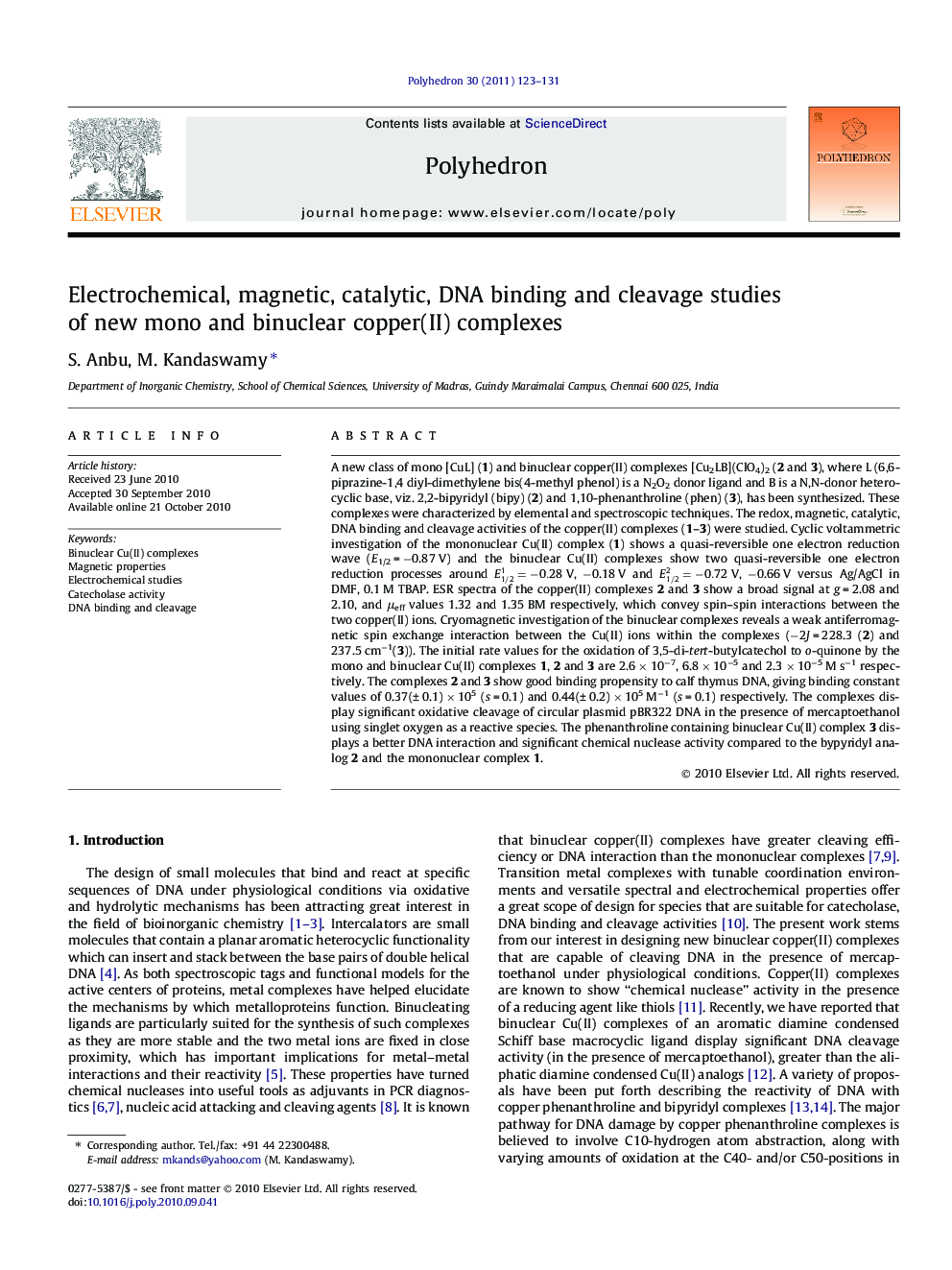| Article ID | Journal | Published Year | Pages | File Type |
|---|---|---|---|---|
| 1336473 | Polyhedron | 2011 | 9 Pages |
A new class of mono [CuL] (1) and binuclear copper(II) complexes [Cu2LB](ClO4)2 (2 and 3), where L (6,6-piprazine-1,4 diyl-dimethylene bis(4-methyl phenol) is a N2O2 donor ligand and B is a N,N-donor heterocyclic base, viz. 2,2-bipyridyl (bipy) (2) and 1,10-phenanthroline (phen) (3), has been synthesized. These complexes were characterized by elemental and spectroscopic techniques. The redox, magnetic, catalytic, DNA binding and cleavage activities of the copper(II) complexes (1–3) were studied. Cyclic voltammetric investigation of the mononuclear Cu(II) complex (1) shows a quasi-reversible one electron reduction wave (E1/2 = −0.87 V) and the binuclear Cu(II) complexes show two quasi-reversible one electron reduction processes around E1/21=-0.28V, −0.18 V and E1/22=-0.72V, −0.66 V versus Ag/AgCl in DMF, 0.1 M TBAP. ESR spectra of the copper(II) complexes 2 and 3 show a broad signal at g = 2.08 and 2.10, and μeff values 1.32 and 1.35 BM respectively, which convey spin–spin interactions between the two copper(II) ions. Cryomagnetic investigation of the binuclear complexes reveals a weak antiferromagnetic spin exchange interaction between the Cu(II) ions within the complexes (−2J = 228.3 (2) and 237.5 cm−1(3)). The initial rate values for the oxidation of 3,5-di-tert-butylcatechol to o-quinone by the mono and binuclear Cu(II) complexes 1, 2 and 3 are 2.6 × 10−7, 6.8 × 10−5 and 2.3 × 10−5 M s−1 respectively. The complexes 2 and 3 show good binding propensity to calf thymus DNA, giving binding constant values of 0.37(± 0.1) × 105 (s = 0.1) and 0.44(± 0.2) × 105 M−1 (s = 0.1) respectively. The complexes display significant oxidative cleavage of circular plasmid pBR322 DNA in the presence of mercaptoethanol using singlet oxygen as a reactive species. The phenanthroline containing binuclear Cu(II) complex 3 displays a better DNA interaction and significant chemical nuclease activity compared to the bypyridyl analog 2 and the mononuclear complex 1.
Graphical abstractA new class of mono [CuL] (1) and binuclear copper(II) complexes [Cu2LB](ClO4)2 (2 and 3), where L (6,6-piprazine-1,4-diyl-dimethylene bis(4-methyl phenol) is a N2O2 donor ligand and B is a N,N-donor heterocyclic base, viz. 2,2-bipyridyl (bipy) (2) and 1,10-phenanthroline (phen) (3), has been synthesized. Cyclic voltammetric investigation of the mononuclear Cu(II) complex (1) shows a quasi-reversible one electron reduction wave (E1/2 = −0.87 V) and the binuclear Cu(II) complexes show two quasi-reversible one electron reduction processes around E1/21=-0.28V, −0.18 V and E1/22=-0.72V, −0.66 V versus Ag/AgCl. Cryomagnetic investigation of the binuclear complexes reveals a weak antiferromagnetic spin exchange interaction between the Cu(II) ions within the complexes (−2J = 228.3 (2) and 237.5 cm−1(3)). The initial rate values for the oxidation of 3,5-di-tert-butylcatechol to o-quinone by the mono and binuclear Cu(II) complexes 1, 2 and 3 are 2.6 × 10−7, 6.8 × 10−5 and 2.3 × 10−5 M s−1 respectively. The complexes 2 and 3 show good binding propensity to calf thymus DNA, giving binding constant values of 0.37(± 0.1) × 105 (s = 0.1) and 0.44(± 0.2) × 105 M−1 (s = 0.1) respectively. The complexes display significant oxidative cleavage of circular plasmid pBR322 DNA in the presence of mercaptoethanol using singlet oxygen as a reactive species.Figure optionsDownload full-size imageDownload as PowerPoint slideResearch highlights► Binuclear Cu(II) complexes are efficient catalysts for catechol oxidation. ► Exchange interaction (-2J) increases with increasing the coplanarity of the ligand. ► The phenanthroline based Cu(II) complex binds with DNA through intercalative mode. ► All the complexes cleave DNA by oxidative pathway.
